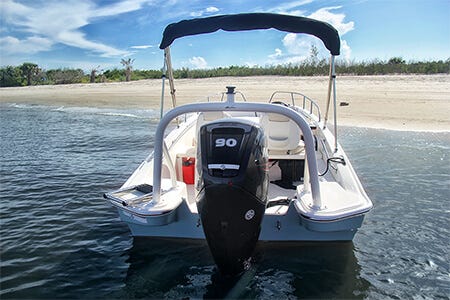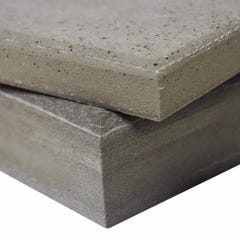What Is a Transom On a Boat? Fixing & Install Tips
November 09, 2023 6 min read


The terms “transom” and “stern” are often used interchangeably, but they have distinctly different meanings. Every boat has a stern, which simply means its back end. But not every boat has a transom, which is a flat or almost flat structural part that spans from the aft (back) end of one of the boat’s sides to the aft end of the other side. A typical canoe, for example, has a stern but lacks a transom, since its sides come together at the stern. A rowboat with a squared-off stern, on the other hand, does have a transom.
On sailboats and some inboard powerboats, transoms may be very small, irregularly shaped, and/or raked (angled) forward or backward. Some sailboats and inboard powerboats lack transoms altogether. Essentially every modern outboard-powered or sterndrive powerboat, though, has a transom that spans roughly the full beam (width) of the boat.
What Are Boat Transoms Made Of?
The transom on this type of boat is where the outboard(s) or outdrive(s) are mounted. That means transoms have to be exceptionally strong.
Not only can modern outboards weigh 1,000 lbs. or more each, but they also exert massive forces on the transom as they drive the boat through the water.
Because of that, transoms are typically constructed with heavier, stronger coring material than other parts of the boat. The sides of a typical recreational powerboat, for example, are often made with sheets of closed cell foam sandwiched between layers of fiberglass. This construction is stiff and lightweight but not strong enough to support hundreds or thousands of pounds of outboards bolted to it.
Heavier Coring Matieral
Instead, transoms are typically made of either marine plywood or a non-wood alternative, such as Coosa board, which has similar strength but doesn’t absorb water or rot. The coring alone may be 1 to 2 inches thick, with two sheets of 3/4” material for a total thickness of 1-1/2” being the most common. Plywood and high-tech composite panels are not only stronger and more rigid, but they also resist crushing, unlike foam coring, which can be easily crushed between a bolt and nut. Outboard motors and outdrives are bolted through transoms, so the material must be able to withstand strong compression. Several layers of these materials are often used in the core of the transom and then sandwiched between multiple layers of fiberglass.
The strongest transom in the world, though, is worthless unless it’s securely attached to the rest of the boat’s structure.
The strongest transom in the world, though, is worthless unless it’s securely attached to the rest of the boat’s structure. Transoms are typically attached to the sides and bottom of multiple-layer fiberglass boats. They are also attached to the bottom of the boat and/or the stringers (forward-and-aft structural members under the deck that stiffen the boat) with so-called “transom knees.” Transom knees are basically brackets (think of the corbels holding up a mantel) that keep the transom from “tilting” forward or backward in relation to the rest of the boat.
Ultimately, transoms serve several purposes on recreational powerboats. They provide a mounting area for the engines or drives, keep water out of the back of the boat, and structurally connect the two sides of the boat at the stern.
Types of Boat Transoms: Full vs. Notched vs. Euro
Nearly all transoms on outboard and sterndrive powerboats fall into one of three basic design categories:
- A “full” transom is vertical or near-vertical and runs more or less straight across the stern from the back end of one side of the boat to the back end of the other side. It is flat or nearly flat across the top and the same height as the boat’s sides.
- A “notched” transom is very similar to a full transom except that it has a lower section in the middle where outboard motors can be mounted. The propeller on an outboard engine has to be below the bottom of the boat to function correctly. On most boats, mounting an outboard to a full transom would place its propeller too high. The notched transom, though, allows the engine(s) to be mounted lower.
- A “Euro” transom consists of a low transom for mounting outboards with a taller “wall” separating the engines from the rest of the end of the boat. Technically, the actual transom on a Euro transom boat is only the aft-most flat area where the motors are mounted. The taller wall is actually a bulkhead, not a transom.
Advantages & Disadvantages
The various transom styles have unique advantages and disadvantages. Notched transoms tend to allow water to slop over the entire transom into the boat when drifting with the stern toward the waves. They also tend to create more engine noise. On the other hand, they’re considered best for fighting powerful ocean fish, since the engines are close to the cockpit, making it easier to “work” a fish around the back of the boat.
Full Transoms
For outboard boats, full transoms typically require the addition of a bracket to allow the engine(s) to be mounted low enough that their props are below the bottom of the boat. The bracket makes it harder to fight fish around the back of the boat and arguably doesn’t offer some of the performance benefits of Euro transoms. On the other hand, they keep water out of the boat much better than notched transoms. For sterndrive boats, full transoms are ideal.
Euro Transoms
Euro transoms are essentially built-in versions of the brackets used to mount outboards on full-transom boats. A full-width bulkhead the same height as the boat’s sides forms the back end of the cockpit, but the hull extends past the bulkhead, ending with a low transom. This keeps water out of the boat effectively but does make it harder to work fish around the stern. One common complaint about Euro transoms is that they make the usable part of the boat smaller. For example, a boat with a notched transom that is 25 feet from bow to transom will have perhaps two more feet of interior deck space than the same boat with a Euro transom.
Transom Issues
Because they’re under so much stress from carrying the weight of engines and receiving the thrust exerted by engines, transoms are a frequent failure point on powerboats. Most transom issues fall into one of two categories — or often into both:
- First, transoms can deteriorate from within, most commonly because their wood coring has become waterlogged and started to rot. Wet wood loses its strength, swells, and often leads to delamination of nearby fiberglass from prolonged exposure to moisture.
- Second, the connections between the transoms and the bottom and sides of the boat can begin to fail, allowing the transom to move in relation to the rest of the boat.
These are closely related problems, and one often leads to the other. If the structural connections between the transom and stringers weaken, for example, and allow the transom to move and flex, that movement can cause cracks in the fiberglass and allow water to reach the wood core and begin rotting it. Likewise, soft, rotting wood can cause the transom to fall apart from the inside out, eventually causing failure of the joints between the transom and the hull sides or stringers.
Regular Instepction
Inspect your transom regularly for cracking, especially in the splashwell area forward of the engine(s) and in the corners where the transom meets the hull sides. Cracking around the transom doesn’t necessarily indicate failure; some cracks are only cosmetic and don’t indicate structural issues. But they are a good sign to investigate further.
Cracking around the transom doesn’t necessarily indicate failure; some cracks are only cosmetic and don’t indicate structural issues.
Flex in a transom is the surest sign of an issue. Watch for movement of the transom on the water, particularly in chop. You can also exert force on the engine(s) with the boat on a trailer or lift to check for movement. Marine surveyors will often stand on the engine’s anti-ventilation plate with the motor tilted down and bounce up and down to check for movement. You can also tilt your engine up and bounce the motor up with your hands on the lower unit.
If you suspect a wet transom or damaged transom, you’ll need to consult a professional repair shop unless you’re fairly handy. For a sure diagnosis, a shop or surveyor will drill a small hole in your transom and take out a core sample for inspection. Transoms can also be diagnosed with infrared imaging devices as well as tapping with a hammer by someone with a well trained ear.
Fixing and Replacing Transoms
A bad transom isn’t necessarily a death sentence for your boat. Again, repairing or replacing a transom requires relatively advanced DIY skills, but it’s certainly doable with some patience and attention to detail. For a good fiberglass repair shop, it’s a routine job.
In the simplest terms, the procedure is this:
- The deck and any other structure impeding access to the inner surface of the transom or removed or cut. The engine(s) and any exterior attachments like trim tabs or swim platforms are also removed.
- Then the inner fiberglass “skin” of the transom is cut away to expose the coring material. The coring is cut and dug out with basic hand tools and elbow grease until the only thing remaining is the outer fiberglass skin.
- Then the transom is rebuilt from the inside with new coring and glass. The coring is bonded to the outer fiberglass skin, laminated together (if two or more layers are being used), and then fiberglassed over from the inside and glassed to the hull sides and stringers.
- Finally, the inner glass is faired and gelcoat is sprayed and finished.
Whether replacing your transom is worth it depends on your boat and your situation. At one end of the spectrum, if the boat is worth less than the cost of the repair, you’ll want to cut your losses and move on. On the other hand, if the hull is otherwise sound, the engine(s) and other mechanicals are in good condition, and you like the boat, replacing a transom is a reasonable proposition.
Keep in mind too that your new transom will likely be far stronger and have a far longer service life, thanks to huge advances in coring materials, resins, and fibers




